
Welcome to our exploration of one of nature’s fascinating creatures: the grasshopper! In this blog, we delve into the remarkable world of these agile insects. Known for their impressive jumping abilities and distinctive chirping sounds, grasshoppers play a vital role in ecosystems around the globe. From their unique anatomy and life cycle to their cultural significance and behaviors, this post will uncover intriguing insights that may surprise you. Whether you’re a nature enthusiast or simply curious about the world around you, join us as we hop into the captivating life of grasshoppers!
Species Diversity: Grasshoppers are incredibly diverse, with over 11,000 known species identified worldwide. This vast number highlights the adaptability of grasshoppers to various environments, from deserts to wetlands. Each species exhibits unique behaviors, physical characteristics, and ecological roles, contributing to the biodiversity of ecosystems. The order Orthoptera, which includes grasshoppers, crickets, and katydids, contains over 20,000 species, showcasing the evolutionary success of these insects.
Taxonomy: Grasshoppers belong to the order Orthoptera, a classification that includes more than 20,000 species. This order is characterized by their jumping ability, with long hind legs adapted for powerful leaps. The diversity within Orthoptera allows for a wide range of adaptations, including variations in size, coloration, and habitat preferences. The study of these insects provides insights into evolutionary biology and the ecological dynamics of the environments they inhabit.
Jumping Ability: Grasshoppers are renowned for their remarkable jumping abilities, capable of leaping up to 20 times their own body length. This impressive feat is made possible by their strong hind legs, which are adapted for explosive power. When a grasshopper jumps, it uses a combination of muscular contractions and elastic energy stored in its body, allowing it to escape predators quickly and travel efficiently in search of food and mates.
Anatomy: Like all insects, grasshoppers have six legs, which are divided into three main sections: the femur, tibia, and tarsus. The structure of their legs allows for both walking and jumping, making them highly mobile. The legs are also equipped with spines and sensory hairs that help grasshoppers navigate their environment. This anatomical feature is crucial for their survival, as it enables them to evade predators and forage for food effectively.
Vision: Grasshoppers possess five eyes: two large compound eyes and three smaller simple eyes, known as ocelli, located between the compound eyes. The compound eyes provide a wide field of vision, nearly 360 degrees, which is essential for detecting movement and spotting predators in their surroundings. The ocelli help with light perception and orientation, enhancing their ability to navigate in various lighting conditions and making them adept at avoiding threats.
Wings: Most grasshoppers have four wings, consisting of two thicker forewings, known as tegmina, and two larger, membranous hindwings. The forewings provide protection and stability during flight, while the hindwings are used for actual flight. When not in use, grasshoppers fold their wings over their bodies, allowing for streamlined movement through vegetation. The ability to fly aids in escaping predators and finding new food sources, as well as facilitating dispersal to new habitats.
Reproduction: Female grasshoppers are prolific reproducers, capable of laying up to 300 eggs throughout their adult life. They typically deposit these eggs in several batches or pods, which can vary in number from 8 to over 150 eggs, depending on the species and environmental conditions. This reproductive strategy ensures that a significant number of offspring survive to adulthood, despite the numerous threats they face in their habitats, such as predation and environmental changes.
Metamorphosis: Grasshoppers undergo incomplete metamorphosis, which involves several stages of growth and development. As nymphs, they typically molt 5 to 6 times before reaching adulthood. Each molt represents a significant growth phase, where the nymph sheds its exoskeleton to accommodate its increasing size. This process allows grasshoppers to adapt to their environment as they grow, gradually developing adult characteristics such as wings and reproductive organs.
Lifespan: The lifespan of many common grasshopper species, from egg to the end of adult life, is approximately 12 months. This relatively short life cycle allows grasshoppers to reproduce quickly and take advantage of seasonal food availability. Environmental factors, such as temperature and food supply, can influence their lifespan and reproductive success, making them sensitive indicators of ecosystem health.
Locust Behavior: Locusts, a type of swarming grasshopper, can form massive swarms that cover up to 460 square miles (1,200 square kilometers). These swarms can reach astonishing densities, containing 40 to 80 million individuals per square kilometer. The swarming behavior is triggered by environmental factors, such as population density and food availability, leading to significant ecological impacts as they consume vast amounts of vegetation.
Feeding Habits: A single locust can consume roughly its own weight in vegetation, about 2 grams, every day. This feeding behavior is particularly concerning during swarming events, as a 1 square kilometer swarm can eat the same amount of food in one day as approximately 35,000 people. This voracious appetite can lead to significant agricultural damage, as locusts can strip entire fields of crops in a matter of hours, impacting food security and local economies. Their feeding habits highlight the importance of monitoring locust populations and implementing effective management strategies to mitigate their impact on agriculture.
Sound Production: Grasshoppers produce sound through a process known as stridulation, which involves rubbing pegs on their hind legs against their forewings. This sound production is used for communication, particularly during mating rituals, where males attract females through their calls. Some species have 80-100 pegs on each leg, allowing for a variety of sound frequencies and patterns. The ability to produce and interpret these sounds plays a crucial role in their social interactions and reproductive success.
Locomotion: Grasshoppers are capable of traveling long distances, with locusts able to fly at speeds of around 15-20 km/h (9-12 mph). This ability to cover large areas is essential for their survival, as it allows them to find new food sources and escape from predators. The combination of their powerful legs for jumping and their wings for flight makes them highly mobile insects, capable of adapting to changing environmental conditions and exploring new habitats.
Nutritional Value: Grasshoppers are an excellent source of protein, often containing 60-70% protein by dry weight. This high protein content, along with essential amino acids, vitamins, and minerals, makes them a nutritious food source for both humans and other animals. In some cultures, grasshoppers are harvested and consumed as a delicacy, highlighting their potential as a sustainable protein source in the context of global food security.
Body Structure: The insect body is divided into three main segments: the head, thorax, and abdomen. Each segment serves distinct functions, with the head housing sensory organs and mouthparts for feeding, the thorax containing the legs and wings for movement, and the abdomen containing reproductive organs and digestive systems. This segmentation allows for specialization of functions, contributing to the overall efficiency and adaptability of grasshoppers in their environments.
Chromosomal Differences: Many male grasshopper species have 23 chromosomes, while females possess 24. This difference in chromosome number plays a role in the genetic diversity of grasshopper populations, influencing traits such as size, coloration, and reproductive strategies. Understanding the genetic makeup of grasshoppers can provide insights into their evolutionary history and adaptations to various ecological niches.
Antennae Function: Grasshopper antennae, which can consist of 20-30 segments depending on the species, are crucial for touch and smell. These sensory organs help grasshoppers navigate their environment, locate food, and communicate with one another. The length and sensitivity of the antennae can vary among species, reflecting adaptations to their specific habitats and lifestyles.
Egg Resilience: Grasshopper eggs are remarkably hardy and can often survive winter temperatures below freezing, sometimes down to -20°C (-4°F) or lower when insulated by soil. This resilience ensures that the eggs can withstand harsh environmental conditions, allowing for successful hatching when temperatures rise in the spring. The ability to endure extreme temperatures is a key factor in the survival and distribution of grasshopper populations across different climates.
Vision Adaptations: The compound eyes of a grasshopper provide nearly a 360-degree field of vision, which is essential for spotting predators and navigating their surroundings. This wide field of view is particularly advantageous in open habitats, where grasshoppers must be vigilant against threats from birds and other predators. The visual adaptations of grasshoppers contribute to their survival and ability to thrive in diverse environments.
Auditory Organs: Grasshoppers possess auditory organs known as tympana, which are located on the first segment of their abdomen, hidden beneath their wings. These organs are sensitive to sound vibrations, allowing grasshoppers to detect sounds in their environment, including the calls of potential mates and the noise of predators. The ability to hear is vital for their survival, as it aids in communication and helps them respond to threats in their surroundings.
Size Variation: The largest grasshopper species, such as the Giant Grasshopper (Tropidacris cristata), can reach lengths of up to 12 cm (about 4.7 inches). This impressive size allows them to occupy a niche in their ecosystems, where they can feed on larger plants and compete with other herbivores. Conversely, some pygmy grasshopper species are tiny, measuring less than 1 cm (0.4 inches) in length. This size variation among species reflects their adaptations to different habitats and ecological roles, showcasing the diversity within the grasshopper family.
Coloration and Camouflage: Grasshoppers exhibit a wide range of colors and patterns, which can serve various purposes, including camouflage and warning signals. Many species have evolved to blend in with their surroundings, making it difficult for predators to spot them. This cryptic coloration is essential for their survival, as it enhances their ability to avoid predation. Additionally, some grasshoppers display bright colors or patterns as a warning to potential predators about their unpalatability or toxicity.
Habitat Preferences: Grasshoppers are found in a variety of habitats, including grasslands, forests, and deserts. Their adaptability to different environments allows them to thrive in diverse ecological niches. Each species has specific habitat preferences based on factors such as moisture, vegetation type, and temperature. Understanding these habitat requirements is crucial for conservation efforts, as it helps identify areas that are critical for their survival and reproduction.
Ecological Role: Grasshoppers play a significant role in their ecosystems as herbivores, contributing to plant population control and nutrient cycling. By feeding on vegetation, they help maintain the balance of plant communities, promoting biodiversity. Additionally, grasshoppers serve as a food source for a variety of predators, including birds, mammals, and reptiles, making them an integral part of the food web. Their ecological contributions highlight the importance of conserving grasshopper populations and their habitats.
Research Importance: Grasshoppers are often used as model organisms in scientific research due to their relatively simple nervous systems and well-studied behaviors. Researchers study grasshopper physiology, behavior, and ecology to gain insights into broader biological principles. Their responses to environmental changes, such as climate fluctuations and habitat loss, provide valuable information for understanding the impacts of these changes on biodiversity and ecosystem health.
Frequently Asked Questions about Grasshoppers:
1. What do grasshoppers eat?
Grasshoppers are primarily herbivores, feeding on a variety of plants. Their diet mainly consists of grasses, leaves, and other green vegetation. Some species may also consume seeds and flowers. Grasshoppers have strong mandibles that allow them to chew tough plant material.
2. How do grasshoppers reproduce?
Grasshopper reproduction typically involves mating during the warmer months. The male grasshopper will attract a female by producing a series of mating calls. After mating, the female lays eggs in the soil or in plant material, often in a protective casing called an ootheca. The eggs will hatch into nymphs, which resemble small adults but lack wings.
3. What is the lifespan of a grasshopper?
The lifespan of a grasshopper varies by species but generally ranges from a few months to a year. Grasshoppers undergo incomplete metamorphosis, meaning they progress through several stages (egg, nymph, adult) without a pupal stage. Environmental factors, such as temperature and food availability, can influence their lifespan.
4. Are grasshoppers harmful to crops?
While grasshoppers are a natural part of many ecosystems, they can become pests when their populations grow excessively, particularly in agricultural settings. Large swarms can cause significant damage to crops by consuming large quantities of vegetation. Farmers often monitor grasshopper populations and may use various management strategies to mitigate their impact.
5. How do grasshoppers communicate?
Grasshoppers communicate primarily through sound, produced by rubbing their hind legs against their wings or bodies in a process called stridulation. This chirping serves various purposes, including attracting mates, establishing territory, and warning others of potential threats.
6. What are the different types of grasshoppers?
There are over 11,000 species of grasshoppers worldwide, with significant variation in size, color, and behavior. Some common types include the migratory grasshopper (Melanoplus sanguinipes), the desert locust (Schistocerca gregaria), and the common field grasshopper (Chorthippus parallelus). Each species has adapted to its specific environment and ecological niche.
7. Do grasshoppers have any natural predators?
Yes, grasshoppers have several natural predators, including birds, reptiles, amphibians, and other insects like spiders and predatory beetles. These predators help control grasshopper populations in their natural habitats.
8. How do grasshoppers adapt to their environment?
Grasshoppers have developed various adaptations to survive in their environments. Their coloration often helps them blend into their surroundings, providing camouflage from predators. Additionally, their powerful hind legs allow them to escape threats quickly by jumping long distances.
9. Can grasshoppers be kept as pets?
Yes, grasshoppers can be kept as pets, though they require specific care. They need a suitable habitat with proper ventilation, humidity, and temperature. A diet of fresh vegetation, such as grasses and leaves, is essential for their health. However, grasshoppers are not as common as pets compared to other insects.
10. What role do grasshoppers play in the ecosystem?
Grasshoppers play a crucial role in their ecosystems as herbivores, helping to control plant growth and contributing to nutrient cycling. They serve as a food source for various predators, thus supporting the food web. Additionally, their feeding habits can help shape plant communities and promote biodiversity.









